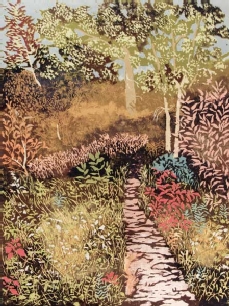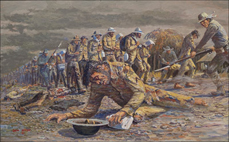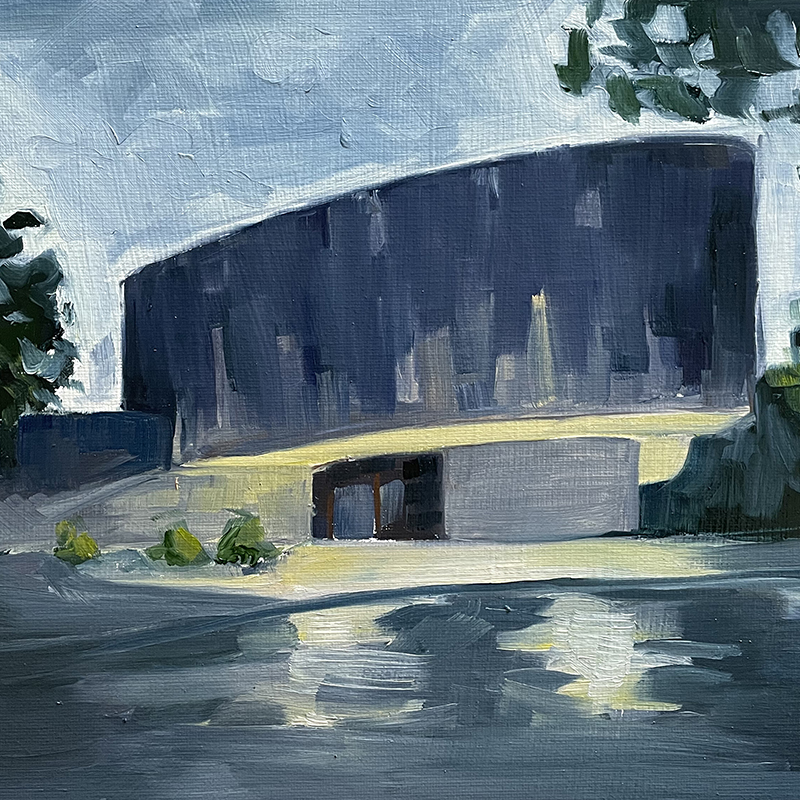2011-2012

Edith Freeman, The Rosy Path,
Undated, Woodcut print,
Collection of the Yellowstone Art Museum
Edith Freeman: Montana Seasons
May 31 - August 25, 2012 | Meloy Gallery
Edith Freeman (1913-1992) was a noted artist and rancher who taught in Billings public schools for over 30 years. Her serene woodblock prints capture the harsh beauty of central Montana in all its varied seasons. A master of reduction woodcut printing, she studied with noted Billings artist Isabelle Johnson. Freeman based her compositions on studies of the prairie, rimrocks, river valleys, wildflower meadows, backyard garden and household plants. This exhibition is drawn from the Yellowstone Art Museum’s significant holdings of Freeman’s work and includes the artist’s woodcarving and printmaking tools. The exhibition is touring under the auspices of the Museum and Art Gallery Directors Association of Montana.
Cultural Homesteaders: Montana Institute of the Arts from the Permanent Collection
May 31 - August 25, 2012 | Paxson Gallery
This exhibition presents the Montana Institute of the Arts (MIA) permanent collection, which began in 1954 when there were few other collecting institutions in the state and none focused exclusively on fine art. Since 1994, this collection has resided with the Montana Museum of Art & Culture (MMAC) at The University of Montana. The history of this collection and the MIA is central to the cultural landscape of Montana. The MIA was a unique organization of artists who acted collectively to enrich the artistic and cultural opportunities across the state at a time when there was not an established or formal cultural infrastructure. The founders and member artists of the MIA were pioneers, supporting one another and creating artistic opportunities during a time when resources were limited. This collection offers the art object as a tangible record of the experiments and sentiments found in Montana art over the course of 30 years, providing an insight into Montana art history.

Nadia Hironaka and Matthew Suib, Whiteout (still)
Still image from film, 2010
Courtesy the artists
Nadia Hironaka and Matthew Suib: Black Hole/Whiteout
March 2 - May 19, 2012 | Meloy Gallery
A collaborative work by Nadia Hironaka and Matthew Suib, Black Hole is an immersive video installation installed in a pitch-black room and projected onto a black screen accompanied by a minimal soundtrack arranged by Eugene Lew. The motif and conventions of film noir serve as a metaphor leaving the viewer awash in a deeper mystery. Black Hole examines power structures and the origins of power, relating these observations to political systems.
Nadia Hironaka and Matthew Suib live and work in Philadelphia where they founded Screening, Philadelphia’s first gallery dedicated to the presentation of works on video and film. Hironaka’s films and video installations have been exhibited internationally at venues including Rencontres Internationals, Paris; Shang Elements MoCA, Beijing, China; The Center for Contemporary Arts, Kitakyushu, Japan; The Fabric Workshop and Museum, Philadelphia; The Institute of Contemporary Art, Philadelphia;The Pennsylvania Academy of Fine Arts, Morris Gallery, Philadelphia; Arizona State University Art Museum, Tempe. She is a recipient of the 2006 Pew Fellowship in the Arts. Suib's projects have been exhibited at Philadelphia Museum of Art; Kunstwerke Berlin; Mercer Union, Toronto; The Corcoran Gallery of Art, D.C.; PS1 Contemporary Art Center, New York; Institute of Contemporary Art, Philadelphia; and the 2007 Moscow Biennale.
Curiosity: Selections from the Permanent Collection
March 2 - May 19, 2012 | Paxson Gallery
The title of this exhibition is a play on the term ‘cabinet of curiosities,’ an expression derived from the German wunderkammer, the encylopedic16th century assemblages that served as the first examples of museum collections. Early cabinets attempted to catalog scientific knowledge and included an eclectic range of geological, natural history and fine art objects that elevated the status and symbolically expressed the collector's worldliness and influence through the breadth and variety of its contents. ‘Cabinet’ originally referred to a room rather than a piece of furniture, though both served as repositories for the wonderful, curious and mysterious.
Meant to provoke, amuse and delight, this exhibition will highlight the seldom seen and hidden aspects of the vast treasury of the Montana Museum of Art & Culture Permanent Collection which numbers nearly 11,000 objects.

Fra Dana, Peonies in a Green Vase,
Oil on canvas, c 1800s
MMAC Permanent Collection
Gift of the artist
Fra Dana: American Impressionist in the Rockies
December 2, 2011 - February 25, 2012 | Meloy Gallery
Fra Dana (1874-1948), a cattle rancher who lived near Great Falls, was one of the leading artists of the Rocky Mountain Northwest at the turn of the twentieth century. Born in Terre Haute, Indiana on November 26, 1874, Dana studied art at the Cincinnati Art Academy, the Art Institute of Chicago and New York School of Art. In 1893, Dana moved with her family to Parkman, Wyoming and met her future husband, Edwin L. Dana. The two married in 1896 and worked together to develop what was by 1918 America’s largest purebred Hereford operation in Montana and Wyoming. Her desire to study and create art was often in conflict with her obligation as a ranch wife.
Dana traveled annually to major urban centers such as New York City, London and Paris to pursue her artistic studies. During her life, she associated with Mary Cassatt, Gertrude Stein, Alfred Maurer and Joseph Henry Sharp and was a student of William Merritt Chase. Her bequest to the Montana Museum of Art & Culture’s Permanent Collection in 1948 of her own artworks as well as those by some of history’s most accomplished artists is central to the richness of the MMAC Permanent Collection and integral to the development of American art. Her collection includes traditional Japanese prints, a large number of prints by Honoré Daumier and Jean Louis Forain and paintings by Joseph Henry Sharp, Alfred Maurer, William Merritt Chase, Douglas John Connah, Elling William Gollings and others.
The Montana Museum of Art & Culture is pleased to announce the forthcoming publication of the first-ever full biography of Dana, authored by Sue Hart, Professor of English, Montana State University – Billings and Dr. Valerie Hedquist, Associate Professor of Art History and Criticism, The University of Montana and edited by Caroline Patterson.
Frances Carroll Brown: Bitterroot Portraits
December 2, 2011 - February 25, 2012 | Paxson Gallery
Granddaughter of Marcus Daly, Frances Carroll Brown had strong ties to Montana and the Bitterroot Valley. She regularly visited the Stock Farm outside of Hamilton to attend social events and celebrate holidays. She traveled to Europe and lived in France before fleeing at the onset of WWII. Her psychological portraits are artistically and historically significant, ranging in subject from workers and day laborers to members of high society. Brown’s work is fundamentally humanistic, revealing a fascination with a variety of racial, religious and class background, emphasizing the essential unity of people everywhere. Frances Carroll Brown’s art contributes to an expanding category of significant female artists who played a compelling role in Montana art history.

Ben Steele, The Bataan Death March,
1880, oil on panel, ca. 1950,
MMAC Permanent Collection
Gift of the artist
Paintings and Drawings from the Bataan Death March
September 23 - November 19, 2011 | Meloy & Paxson Galleries
The Montana Museum of Art & Culture exhibits the art of WWII Veteran, Bataan Death March survivor and Montana artist Ben Steele. As a POW, Steele endured 41 months of starvation, dehydration, hard labor, torture and Japanese ‘hell ships’ while crippled by dysentery, pneumonia, malaria, blood poisoning and beri beri. As a prisoner, he created drawings which record the Japanese invasion of the Philippines, the capture of American and Filipino POWs and the degradation and cruelty to which the prisoners were subjected. Steele credits art for his survival and recovery. His record of the Bataan Death March is an aesthetic and historical testimony by a native son who taught generations of art students at MSU - Billings. Part of the MMAC Permanent Collection, this gift by Ben and Shirley Steele is an important part of Montana’s cultural heritage. The exhibition coincides with the 38th annual Montana History Conference at UM, themed “No Ordinary Time: War, Resistance and the Montana Experience” taking place September 22-24, 2011.
